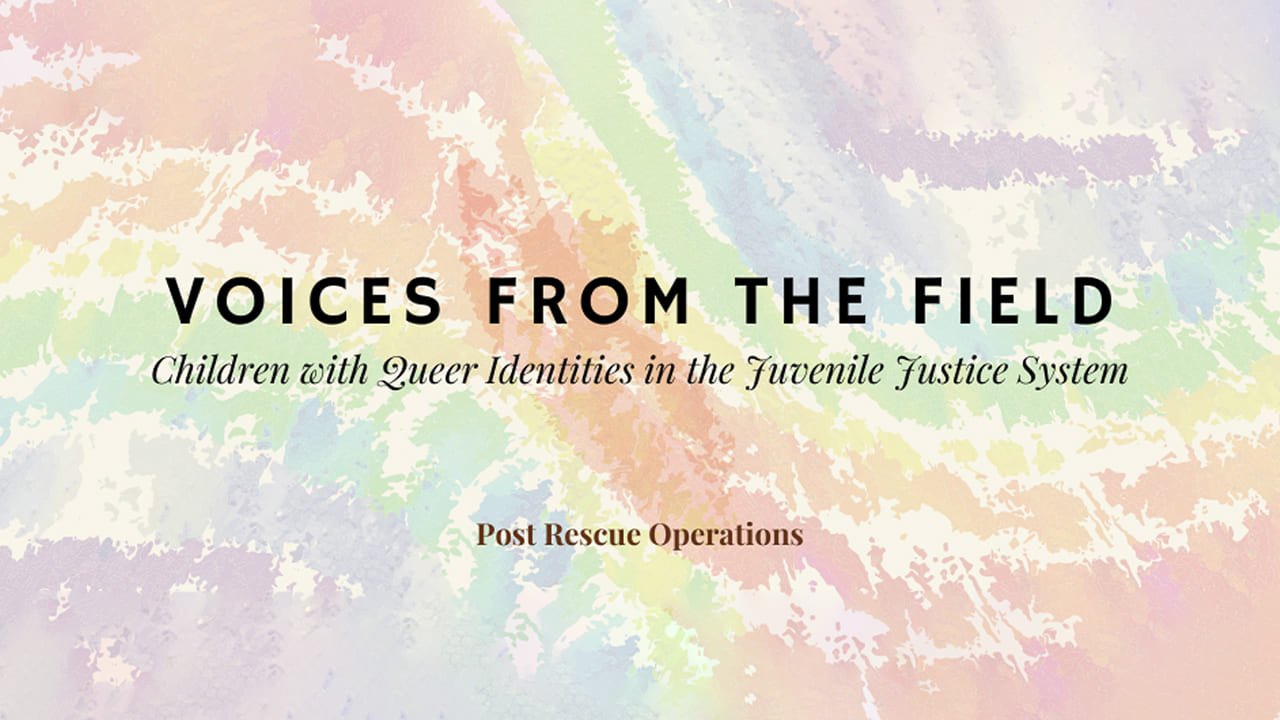SHRADDHA POL
Counsellor (Post Rescue Operations)
Prantik*, a 16-year-old child, is from a low-income family of Mumbai and is the fourth among nine children in his immediate family. The child’s father has been working as a driver and two elder siblings have been working as domestic workers in others’ houses. Prantik’s mothers suffers from a mental health disorder.
Prantik was referred into the Juvenile Justice system in 2019 as a victim of sexual violence. At that point of time, the child was 13 years old and had been rescued from a railway station when he was attempting to leave the city unaccompanied. The child was referred to Prerana in March 2019. The Child Welfare Committee[1] had appointed Prerana to conduct a social investigation (a socio-economic assessment of the child’s family and background) in this case to understand the child’s background and accordingly decide on his rehabilitation.
Affirming the Child’s Gender Identity
During Prerana’s interventions with the child over the last 2 years, Prantik* who was born with male genitalia, specified that he would prefer to be referred to as a girl and thus would prefer the pronouns she/her. At Prerana, we truly believe that a child’s right to self-determination plays a crucial role in the way the child perceives the world and interacts with it. Hence, we are mindful that we are respectful of their choices. In this child’s case, Prerana will continue to use the pronouns ‘she/her’ for the child and refer to the child by her preferred name which is Sakshi*.
Systemic Challenges
From March 2019 to the present time, Sakshi has been transferred to 5 different Child Care Institutions (CCIs) for about 8 times. While there have been different reasons for her transfer each time, one important reason has been the challenges that CCIs face to support children who are exploring their gender identity. In Sakshi’s case, most of these institutions and its staff had never interacted with children who exhibited different gender identities or sexualities and were thus, unable to support her in the best way.
While Prerana was working with the child, a certain CCI shared their apprehensions with the social worker from Prerana stating that they were worried that Sakshi’s gender identity would have a negative influence on the other children because her manner of expressing her gender was not perceived as ‘normal’. The institution also shared their concerns about Sakshi’s sexuality because she seemed to be sexually interested in her peers at the Institution. At this point, Prerana’s social workers attempted to sensitize the staff at the CCI but this was at best, a temporary intervention. When social workers interacted with another CCI where the child had been admitted, they realised that the staff were relatively better equipped to guide her and ensure that she felt accepted. This was because there had been some other children in the past who had expressed their gender identities and sexuality within the institution. This experience had sensitized the staff because of the need that arose from their previous cases.
An essential space within the Child Protection ecosystem must be dedicated to children from marginalized groups who might have varying needs. It is of utmost importance that the child is guided and mentored well so that they feel comfortable and find strength in their identities. This is how the Principle of Individualization has to unfold on the ground where each child is respected and is able to live a life of dignity. Gender sensitization has to be extended to all stakeholders within the system for prolonged periods of time to see sustainable results. This needs to be fulfilled systemically besides individual CCIs having to sensitize themselves during interventions.
Prerana’s Interventions
Social Investigation
Prerana was asked to conduct a social investigation along with another civil society organisation that implements the railway childline project by the Child Welfare Committee (CWC). The social workers visited Sakshi’s house and met her siblings and parents. They verified all information and the parents disclosed that the child had been expressing her gender identity differently within the house as well. When social workers visit homes of children, it is essential for them to observe cues which would indicate how safe the child might be within their own homes. Additionally, social workers also tried to understand the reasons behind Sakshi moving out of her home unsupervised and being found in the railway station.
In the initial interactions with the child, Sakshi had mentioned that her father was abusive and an alcoholic. These statements were confirmed by the social workers on their interaction with Sakshi’s siblings. The social workers submitted the Social Investigation Report to the respective CWC in March 2019.
Assisting the child to cope with Institutional care
Prerana’s interventions with Sakshi were focused on understanding her needs and supporting her within institutions. These interventions included providing her with counselling support, helping her plan her further education, identifying her areas of interest, understanding her struggles as a child from the LGBTQ community, and acknowledging her gender identity.
The team also identified the need to follow up regularly with the police to ensure that an FIR was filed against the perpetrators who were responsible for the abuse that Sakshi had faced. After following up for over 4 months, the social workers were finally able to register an FIR in August 2019.
Social workers also encouraged Sakshi to focus on her studies even though she had to be shifted multiple times. They discussed her goals and even conducted educative activities with her to engage her better and gauge her cognitive abilities. In this year of Prerana’s interventions, the team observed a deterioration in her mental health. One cause for the same was that she was being shifted repeatedly from one institution to the other. Sakshi also exhibited signs of emotional trauma in Prerana’s interactions with her. This included a lack of trust, lack of emotional stability, threats to run away and suicidal thoughts. Both Prerana and the partner organisation worked with her to build her trust in the social workers, supported her through all her concerns and worked towards understanding her needs so that she can be linked to the right resources.
Connecting the child with a resource person from the LGBTQ community
After a year of Prerana’s interventions with the child along with other CSOs, it became clear to all the social workers involved that the child was struggling in spite of all the support provided to her. Knowing all that she had been through and with the hope of helping her get additional support, Prerana’s social workers identified the need to mobilise a resource person from the LGBTQ community. The team then approached an individual who is a well-known Queer Rights activist in Mumbai. The social workers obtained all the prerequisite permissions from the CWC before introducing the resource person to Sakshi.
From the start of their interaction, it was evident that Sakshi felt comfortable around this individual and there was a sense of mutual respect between the two of them. Sakshi openly expressed her feelings and shared intimate details about herself including the abuse she had faced. She had never shared any of these details earlier. Prerana’s social workers recognized the importance of introducing the child to someone whom she might resonate with and this steered the progress of the child in a positive direction. This individual was the first person to ask Sakshi what her new name for her new identity was after having met her. He also asked her about her preferred pronouns. The individual also spoke to Sakshi about her sexuality and her gender identity. They discussed about Sakshi’s emotions and feelings of belonging to a different gender than what was assigned at one’s birth, commonly referred to as gender dysphoria. He also discussed with Sakshi about the society’s responsibilities for creating safe spaces for people like her who are exploring their gender identities. This helped her understand that she was not at fault if she did not feel safe in her surrounding environment.
Concluding Thoughts
Children from the LGBTQ community who are a part of the Juvenile Justice system might face oppression within a system that is expected to support and protect them. On one hand, it is critical to ensure that all stakeholders are sensitive to the needs of children from this community but on the other hand, it is also important to identify when the need arises to involve queer persons directly for better guidance. Social workers must always remember that children who are oppressed due to their identities might find it difficult to open up to others from outside these identities. This could primarily be because of a lack of trust and feeling that no one will be able to understand what they are going through. In these kinds of situations, involving a resource person from the community will help the child open up and be more receptive. It might also help the child affirm their identities and sexualities.
*Please note that the child’s birth name and preferred name have both been changed to protect her identity.
[1] a Quasi-Judicial body set up under the Juvenile Justice Act to take decisions for the care and protection of children








